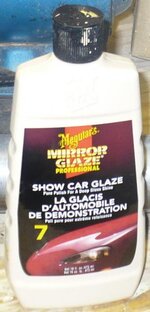CaRed
Member
I have been lurking in cyberspace on this forum for a while reading many great articles and learning much. I have not turned a pen yet since I am practicing my finishing on scrap pieces of cherry.
I have an issue I have been unable to fix even after searching the forums for a few hours. I am using Minwax Wipe on Poly gloss finish. I sanded the piece to 1200 grit and was happy with the finish. Initially, I tried to wipe on the poly but it seemed to absorb and there was not much of a finish on the pen. I decided to dip the pen. This seemed to work fine. I dipped, let the pen dry for about 4 hours, used steel wool to buff, cleaned the blank with DNA and reapplied another coat. I let the final coat dry for about 6 hours and made sure there was no tackiness before buffing. This is where my problems started. The piece looked very nice but needed to be smoothed out.
I purchased a buffing kit at Harbor Freight which had a buffing wheel (assumed cotton but didn't specify), white oxide stick and red rouge. I did purchase separate buffing wheels. I applied the red rouge first and then the white oxide.
My first attempt was what I would call a failure. After the coating dried, I used 600 and 1200 wet/dry then buffed. After buffing, there seemed to be a loss of color and much of the piece was almost shaded white. It resembled something like dust left in the scratch pattern. But, I cleaned with DNA after each sanding. Next time I eliminated the sanding and just buffed the piece. The finish was very smooth but not very glossy. Some of the finishes I have seen in "show off your pens" have been nearly glass like. The gloss and color before buffing seems to have been lost in buffing.
I have never buffed before and just wonder if I am missing something. I buffed at about 1500 rpm on a six inch wheel. I am not asking for much just a perfectly smooth finish with a mirrow like appearance.
Any help would be appreciated.
p.s. I just want to thank everyone in advance who responds for your time and efforts to help the less knowledgeable. We all still learn by trial and error but with the help we can eliminate many of the errors.
I have an issue I have been unable to fix even after searching the forums for a few hours. I am using Minwax Wipe on Poly gloss finish. I sanded the piece to 1200 grit and was happy with the finish. Initially, I tried to wipe on the poly but it seemed to absorb and there was not much of a finish on the pen. I decided to dip the pen. This seemed to work fine. I dipped, let the pen dry for about 4 hours, used steel wool to buff, cleaned the blank with DNA and reapplied another coat. I let the final coat dry for about 6 hours and made sure there was no tackiness before buffing. This is where my problems started. The piece looked very nice but needed to be smoothed out.
I purchased a buffing kit at Harbor Freight which had a buffing wheel (assumed cotton but didn't specify), white oxide stick and red rouge. I did purchase separate buffing wheels. I applied the red rouge first and then the white oxide.
My first attempt was what I would call a failure. After the coating dried, I used 600 and 1200 wet/dry then buffed. After buffing, there seemed to be a loss of color and much of the piece was almost shaded white. It resembled something like dust left in the scratch pattern. But, I cleaned with DNA after each sanding. Next time I eliminated the sanding and just buffed the piece. The finish was very smooth but not very glossy. Some of the finishes I have seen in "show off your pens" have been nearly glass like. The gloss and color before buffing seems to have been lost in buffing.
I have never buffed before and just wonder if I am missing something. I buffed at about 1500 rpm on a six inch wheel. I am not asking for much just a perfectly smooth finish with a mirrow like appearance.
Any help would be appreciated.
p.s. I just want to thank everyone in advance who responds for your time and efforts to help the less knowledgeable. We all still learn by trial and error but with the help we can eliminate many of the errors.

